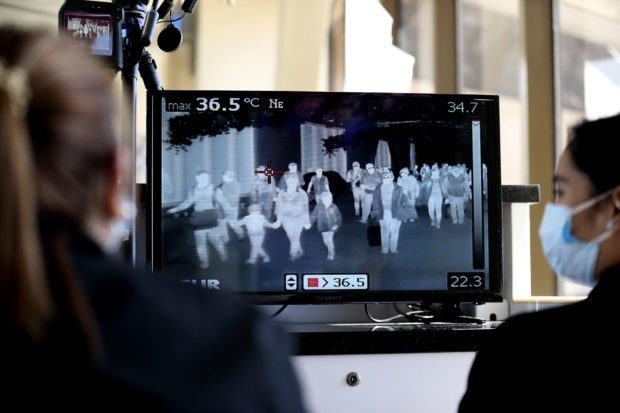
Passengers arriving at Ninoy Aquino International Airport in Pasay City are monitored for fever using a thermal scanner on Jan. 22. Image: Richard A. Reyes/Philippine Daily Inquirer
CEBU CITY, Philippines – Health authorities in the country have set into motion the contact tracing mechanism involving the 38-year-old Chinese woman, who entered the country as a tourist on January 21 and who is now the first patient confirmed on having the 2019 novel coronavirus (2019-nCoV) or the Wuhan coronavirus.
Based on flight information that DOH gathered, the woman had apparently traveled to the cities of Cebu and Dumaguete, both located in Central Visayas, before she was confirmed to have a contracted the virus while confined in a still unnamed place or hospital in the country.
Top officials of the country’s health bureau announced that a woman confined in a government-ran hospital, whose location was not disclosed, tested positive for the 2019 – nCoV during a press conference on Thursday afternoon, January 30.
Director Chito Avelino, head of DOH’s Epidemiology Bureau, told reporters they will closely coordinate with their counterparts in Central Visayas for the contact tracing.
Avelino said they already requested flight information details of the 38-year-old patient from the Bureau of Quarantine (BOQ), including the places she has recently visited.
“We requested for the flight details and carriers and saan pumunta (where she went) after we have gathered info from patients… We also coordinated with Region 7. We are looking at the places they’ve been to in Cebu and Dumaguete,” said Avelino.
“Once we have seen any of these traces, then we do the contact tracing – we need to identify passengers in the front, at the back and at both sides and contact them and advise them accordingly,” he added.
He also advised owners and workers of establishments visited by the patient to undergo mandatory quarantine.
“We’re looking into the establishments where they stayed and advised the establishment owners to advise the employees that have been in contact with the patient to identify them, and do a mandatory quarantine to observe if they manifest any signs or symptoms of respiratory illness,” Avelino said.
Health Secretary Francisco Duque III said the female patient arrived in the country from Wuhan City via Hong Kong on January 21. He added that she was admitted to a hospital after having mild cough four days later – or on January 25.
“The laboratory results (of the 38-year-old patient) arrived today (Thursday, January 30), from the Victorian Infectious Disease Reference Laboratory,” Duque said.
He added that the patient is asymptomatic, which means that she has not showed any flu-like symptoms such as fever that suggest she is ill at this point.
Duque also said they are closely coordinating with the health staff and management of the hospital where the patient is currently confined.
“We are working closely with the hospital where the patient is committed. Specifically in infection control, case management and containment, we will be implementing measures to the health staff providing care for this patient,” said Duque.
He also said BOQ remain in high alert “for stricter border surveillances.”
Meanwhile, the country’s health bureau vowed that all necessary precautionary measures will be taken to prevent the virus from spreading to other parts of the country.
“The public is assured that the DOH is on top of this evolving situation. We were able to detect the first confirmed case because of our strong surveillance system,” Duque said.
Duque also urged everyone not to panic, and channel their focus instead on practicing hygiene to prevent contacting the virus.
“Finally, I urge the public to remain calm and be vigilant. And to keep practicing hygiene,” he added.
DOH officials disclosed that a total of 29 patients under investigation (PUI) were recorded in the country since early this month. They added that the figure was down now to 23 after six were discharged for testing negative of the 2019-nCoV.
Of the 23 currently being monitored, DOH records showed that two of them are still confined in hospitals in Central Visayas. Where in Central Visayas was not disclosed.
The 2019-nCoV, also known as the Wuhan coronavirus, has spread to more than 10 countries outside China – such as Japan, Taiwan, Singapore, Malaysia, Thailand, Hong Kong, Macau, Australia, United States, Vietnam, France, United Arab Emirates, Canada, Germany, Cambodia, Finland, Nepal, and Sri Lanka, according to John Hopkins University’s online tracker.
The death toll, as of January 29, was at 170 – all of which are in mainland China./ elb
Note: This is a detailed story of an earlier article published. See the breaking story here